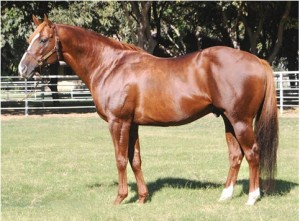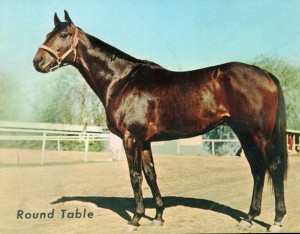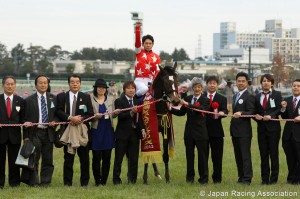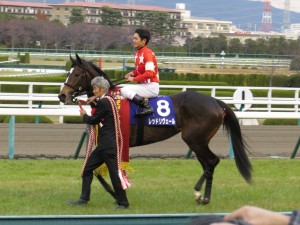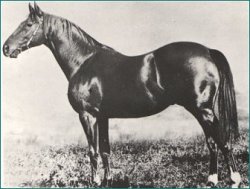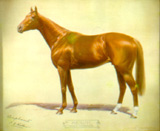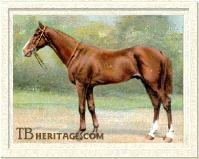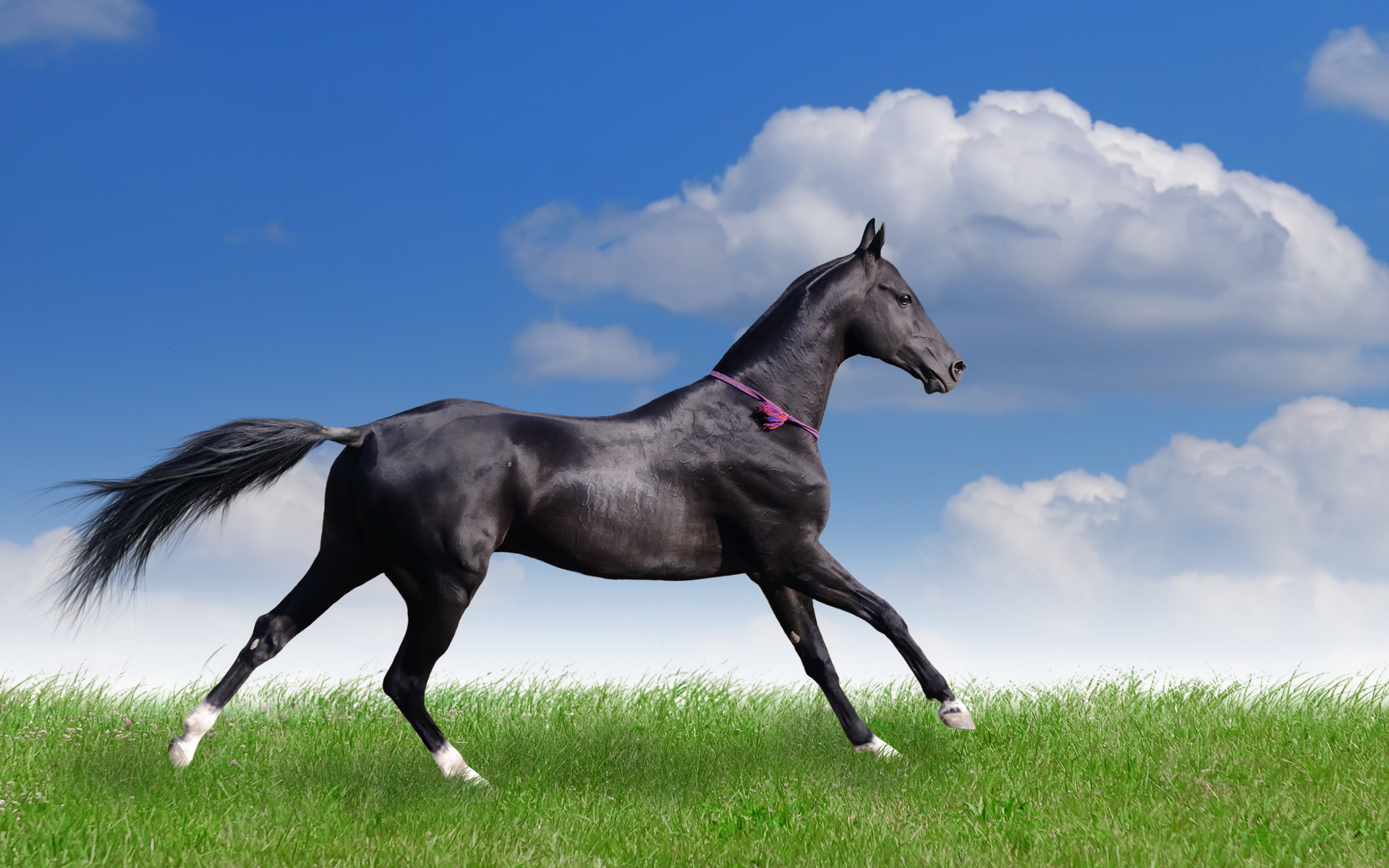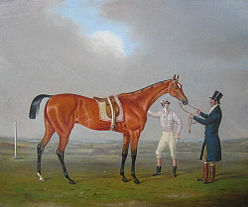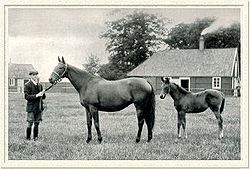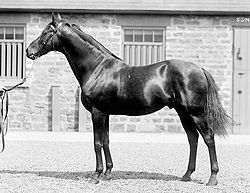Jul 16
Tonalist
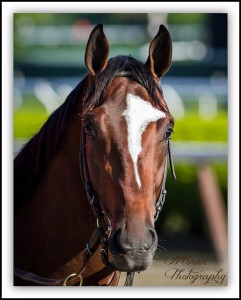 Saturday saw another Triple Crown dream come to an end as the popular colt California Chrome failed to show his usual verve and went down to defeat as have so many other hopefuls over the last 36 years. All of the post race drama took the spotlight off the winning horse Tonalist, a horse which epitomizes the pedigree cross highlighted in Breeding by Design. If you follow Tonalist’s male line you find his great grandsire is A. P. Indy. This male line is doing very well as witnessed by the fact that all of the winners of the Triple Crown races this year are sired by sons of Pulpit who is a son of A. P. Indy.
Saturday saw another Triple Crown dream come to an end as the popular colt California Chrome failed to show his usual verve and went down to defeat as have so many other hopefuls over the last 36 years. All of the post race drama took the spotlight off the winning horse Tonalist, a horse which epitomizes the pedigree cross highlighted in Breeding by Design. If you follow Tonalist’s male line you find his great grandsire is A. P. Indy. This male line is doing very well as witnessed by the fact that all of the winners of the Triple Crown races this year are sired by sons of Pulpit who is a son of A. P. Indy.
A. P. Indy traces down his female line to Cluster Mare Missy Baba who is his 4th dam. Missy Baba is also the 4th dam of Tonalist himself. This is a classic case of the sire line reinforcing the direct female family as put forth in my book. This is one of the proven ways to create the pedigree pattern that often leads to Cluster mares. Not only is the pattern likely to produce a cluster mare, but classic winners often exhibit the same pattern. In this case it is the classic winner that is the result, however if Tonalist were to have a full sister she might turn out to be a Cluster Mare.
There is much to like about the pedigree of Tonalist but the most important tidbit of information coming from his classic win in the Belmont is that it solidifies the position of his sire Tapit as the emerging leading sire in North America. One could then conclude that Tapit’s sire Pulpit is also a horse that needs careful evaluation as a sire of sires. After all it was one of his unheralded son’s Lucky Pulpit that sired California Chrome. Check out the pedigree of Tonalist here.
Something more important can be garnered from this year’s Belmont and the ill advised losing rant by California Chrome’s co-owner Steve Coburn. I was advising Edurado Gaveria the breeder of Real Quiet, and was there when his Triple Crown dreams went down by the closest of noses. However, Mr. Coburn’s rant is not what is important. What is important is what could be called “The Decline and Fall of the American Thoroughbred.” One of the reasons I developed this web site is so that I can say whatever I want about the Thoroughbred without someone else editing it or having it in any way censored.
There is nothing wrong with the Triple Crown races as they are now constituted. The problem lies in how the American Thoroughbred horse is bred and trained. To begin most of the American thoroughbreds are not bred to run! They are bred for the Market! That in itself is a big problem. Just think how differently you would breed horses if you couldn’t sell them and had to race them all yourself. So let’s begin to examine American Racing both in the past and present and try to get an idea as to why the American Thoroughbred is weakening.
I’ve been involved in Racing for 60 years now, but I started as a fanatical racing fan. When I graduated from High School in 1959 at age 17 I was five feet tall and weighed 100 pounds. I wanted to be a Jockey. However, I grew one foot during the next 14 months and my dreams of being a Jockey and winning the Kentucky Derby went down the proverbial drain. At that time my Uncle Nick was the Chauffer for Louis E. Wolfson the owner of Harbor View Farm and later the breeder of Triple Crown winner, Affirmed. Uncle Nick placed all of Mr.Wolfson’s bets which were very large. Quite a few times in a week Uncle Nick was at Aqueduct or Belmont to make the wagers. Whenever he went on the weekend I would go along and sit in Harbor View Farm’s box seat and be tutored by Burly Parke and Lucien Lauren on the intricacies of Thoroughbred Racing. At the time Lucien Lauren had a public stable and it would be another 12 to 13 years before Riva Ridge and Secretariat fell into his care.
 In those days my Favorite horse was Round Table, who by today’s standards was a mighty animal indeed. Between May 30th and November 1st of his three-year-old year he started 11 times and won all 11. Divide 11 races into the 154 days the dates cover and you realize Round Table ran every 2 weeks for 5 months and won every race. Three of those wins were over 1 ¼ miles and two of those races were against older horses (Hollywood Gold, and Hawthorne Gold Cups). The final 1 ¼ mile race was the American Derby against his own age group. During his career Round Table carried 130 pounds or more 25 times and won 17 of those races. Career Totals-66 Starts 43 wins and world record earnings. When was the last time you saw a horse carry 130 pounds? (Maybe 15 years ago).
In those days my Favorite horse was Round Table, who by today’s standards was a mighty animal indeed. Between May 30th and November 1st of his three-year-old year he started 11 times and won all 11. Divide 11 races into the 154 days the dates cover and you realize Round Table ran every 2 weeks for 5 months and won every race. Three of those wins were over 1 ¼ miles and two of those races were against older horses (Hollywood Gold, and Hawthorne Gold Cups). The final 1 ¼ mile race was the American Derby against his own age group. During his career Round Table carried 130 pounds or more 25 times and won 17 of those races. Career Totals-66 Starts 43 wins and world record earnings. When was the last time you saw a horse carry 130 pounds? (Maybe 15 years ago).
My first point is this, how can you have a sport with no hero’s? I followed every race in which Round Table was entered. I wrote his Bio in the Great Thoroughbred Sires of the World. What do you think the odds would be of my sitting here writing this to you if there had been no Round Table? The first problem with Thoroughbred Racing is that its hero’s are retired to stud too early. You might say it is penny wise and pound foolish. A lot of money is to be made with commercial stallions, but only if there is a thriving racing sport. A diminishing racing industry means the disappearance of high priced stallions. Just a few years ago the United States stood the 5 top commercial stallions. Last year in 2013 not one of the 5 top commercial stallions stood in the United States. I hate to tell you this dear readers but we are Bastardizing the American Thoroughbred.
Why? The answer is obvious, greed! It’s almost the same as inflating the dollar. Don’t make the dollar your god if you’re going to debase it. Which we are doing! A further example of greed destroying the American Thoroughbred is the use of drugs. First it was steroids and now Lasix. Here is a little story which is very revealing.
In 2000 I retired as a General Manager with American Airlines to go back to the farm and raise Thoroughbreds. I wanted to be hands on because I wanted to see if how the horse is raised contributes to his success on the racecourse. I found out that it does. To do this I managed my good friend’s Honey Acres Farm in Maryland. Alan S. Kline my friend flew in one of the best farriers in Kentucky every 5 weeks to do the horses feet. This took about two days and I always held the horses while the farrier trimmed their feet. So, for two days I talked to the blacksmith who had spent years at the racetrack and who turned out to be a treasure trove of information.
One of the topics of conversation was drugs in particular steroids. The farrier related that he had seen a horse come in from France (where he couldn’t win) looking like a skinny little deer. Five months later the horse looked like Secretariat and went on to become Horse-of-the-year. How did this horse make such a dramatic turn around. Can’t be proven, but my guess would be steroids. Then there was Big Brown! I was a big fan of Big Brown until I found out about the steroids. The question then would be how well would he do at stud? Apparently not very well. How good was he really, without drugs?
So, we got past steroids and now we have Lasix. We know it is a performance enhancing drug. We also know that about 1% of horses are real bleeders, then why do 95% of Thoroughbreds in the United States run on it?
As a result of the debilitating effects of Lasix there is no way you will ever see a horse like Round Table that ran every two weeks for 5 months and won all of his starts. To make matters worse they have begun to move major Kentucky Derby preps further and further from the actual race. The Wood Memorial used to be run two weeks before the Derby now it is a month before the Derby. Why? The standard explanation is the trainers like more time between races, but the truth is more likely that horses running on Lasix need more time between races to overcome its debilitating effects. Getting back to Steve Coburn’s rant. If horses need more time between races because they’re using debilitating drugs, how will any put 3 big races together within 5 weeks. The answer is they won’t, but we are the ones making it impossible. This coming August the Jockey Club will meet. The Chairman says, if a solution to race day medication is not found by then, the Jockey Club will ask Congress to pass Legislation. I hope they do.
One final thought on the decline of American racing and how we are causing it ourselves. From reading this Website you can see that I’m deeply involved in the concept of Cluster Mares. Whether or not you realize it, they are the building blocks of the breed. When Dennis Craig came up with this idea in the early part of the 20th century he used specific classic races run over a distance of ground to determine which mares represent a concentration of classic speed. Each country had its own races which would allow mares to earn Cluster Mare status. In Great Britain those races are; The Derby, Oaks, 1,000 Guineas, 2,000 Guineas, St. Leger, Ascot Gold Cup, Eclipse, King George VI and Queen Elizabeth Stakes. Nothing has changed in Great Britain since the book was published in 1964.
In the United States the races that were used to determine Cluster Mare status were; Kentucky Derby, Preakness Stakes, Belmont Stakes, Travers Stakes, Withers Stakes, American Derby, Arlington Classic, Jockey Club Gold Cup, and Saratoga Cup.
Of these races the Withers, American Derby, Arlington Classic, and Saratoga Cup are either no longer viable because of downgrading or extinction. For fillies and mares I’ve used the Kentucky Oaks, Coaching Club American Oaks, Alabama Stakes, Acorn Stakes, and Mother Goose.
Of course now we have the Breeder’s Cup and the Filly and Mare Distaff, Breeders Cup Mile, Breeders Cup Turf and Breeders Cup Classic which can be substituted.
Here’s the point. Do you remember the great Ruffian? I thought she was the greatest racemare I’ve ever seen. She was never headed at any call in any race. Her past performance was just a straight line of 1’s . For example in the Mother Goose Stakes for the half in :47 3/5 she was 1st by 1 ¾. At six furlongs in 1:11 3/5 she was 1st by 2 lengths, after a mile in 1;35 3/5 she was 1st by 8 lengths, then at the finish of 1 1/8 miles she was 1st by 13 ½ lengths in 1:47 4/5. Does this make her a great horse? My mentor Abram s. Hewitt told me a great horse is one that can carry weight, over a distance of ground, against first class opposition. In the Coaching Club American Oaks Ruffian proved her greatness. Her jockey Jacinto Vasquez said, “She broke out of the gate running, she finished running, and left them all in the dust.” Ruffian proved her greatness running 1 ½ miles on the lead.
Now those that control racing in New York have first lowered the Coaching Club American Oaks distance from 1 ½ miles, to 1 ¼ miles then to 1 1/16 miles. They have destroyed an American Classic Race. Furthermore, It was the only race in the United States at 1 ½ miles on dirt for any female of any age. How could anyone with any knowledge of Thoroughbred History be that ignorant? The truth is, it’s easy, it was done by a bureaucrat not a horseman. The decline of the races used to determine Cluster Mare status parallels the decline of American racing.
One final point! Remember Erin Burnett from CNBC financial channel? She moved over to CNN a few years ago. When I’ll Have Another couldn’t run in the Belmont Stakes she proved she was a pretty good reporter by going to the last living person to train a Triple Crown winner to try to get the answer to why American bred horses which used to be so tough were weakening. Billy Turner told her that many were subjected to such severe training to get them ready for two-year-old in training sales that they didn’t last long on the racetrack. Just look at the last few years and review how the Champion two-year-olds did as three-year-olds. Then look at how many of the top classic candidates did in the spring of this year; they were dropping like flies.
Sixty years ago I heard this story in church. Two golfers where out on the fairway when one of them had his ball land on an anthill. He walked up and set himself and swung at the ball. He missed but in doing so he killed 5,000 ants. The next swing also missed and another 5,000 ants were killed leaving only two left alive. Before the golfer could take his next swing one ant said to the other, “We better get on the ball”. So dear readers, if American Racing is going to survive we had better, “Get on the Ball”
Jul 16
Australia
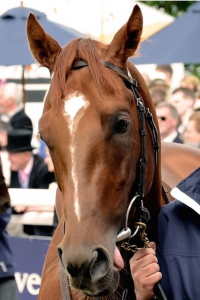 When Australia cantered to victory in the Irish Derby he began to look more and more like the eventual successor to his sire Galileo. That is a lofty peak to scale seeing that standing in his way is another son of Galileo the undefeated Frankel. Since they both have the same sire the determining factor will come from their dams. It is in this area that Australia has a distinct advantage.
When Australia cantered to victory in the Irish Derby he began to look more and more like the eventual successor to his sire Galileo. That is a lofty peak to scale seeing that standing in his way is another son of Galileo the undefeated Frankel. Since they both have the same sire the determining factor will come from their dams. It is in this area that Australia has a distinct advantage.
Before we get into the advantage Australia has over Frankel on the dam’s side let’s look at Galileo and the progression that took place to make him what he is. Galileo has both a dam (Urban Sea) and a granddam (Allegretta) which are Cluster mares. Galileo has a classic winning half brother in Sea the Stars who has already sired a classic winner in his first crop in Oaks winner Taghoora. Rumor has that another Sea the Stars colt Sea the Moon will be favored in the German Derby on July 6th. Galileo is already the worlds leading sire and now his half brother is emerging as another serious classic stallion. The most reasonable explanation for this is that Urban Sea and her dam Allegretta represent a concentrated form of classic speed. They pass this speed on to their numerous offspring. If you refer back to my original essay in Broodmaresinc.com I take the following quote from the master breeder Federico Tesio. He said, “The dam of a popular stallion is a female who through him can produce many offspring in 11 months.”
Galileo and Sea the Stars are pumping the blood of their dam Urban Sea into the thoroughbred gene pool 100 times faster than she can. They have hundreds of foals per year while their dam can only produce one. This helps to explain the importance of cluster mares and their relationship to their sons. Now let’s look further into the pedigree of Galileo, and then his son Australia.
Galileo 4
Galileo sire is Sadler’s Wells. His dam is not a Cluster Mare but, his 2nd dam Special is a star mare and his 4th dam Rough Shod is a Cluster Mare. Sadler’s Wells is a son of the great Northern Dancer whose dam Natalma is a Cluster mare as is his 2nd dam Almahmoud.
Moving further up the sire line we come to Nearctic whose 2nd dam Sister Sarah is a Cluster Mare as are his 3rd, 4th and 5th dams. Nearctic is sired by Nearco whose dam Nogara is a Cluster Mare as is his 2nd dam Catnip. Finally, Nearco is by Pharos whose dam is Scapa Flow another star mare. It’s easy to see the progression that kept the male line alive. What is truly amazing is that unless you were aware of Cluster Mares and their influence on the breed when you looked at Galileo’s pedigree you would not be able to discern what you were looking at.
Another key ingredient in evaluating Galileo’s pedigree is that once you learn that his pedigree is loaded with Cluster Mares you might come to the conclusion that all of this was just a major coincidence. However, this is not the case and it is the reason that I will go out on a limb and project that Australia will follow his illustrious sire’s footprints into stallion stardom. If 50,000 mares are foaled world wide each year only one or two will develop into a Cluster Mare. The odds of having a Cluster Mare fall into your hands are 50,000 to 1. So with so few Cluster Mares floating around how did so many end up in Galileo’s pedigree.
To understand this we have to go back to the concept that a Cluster Mare represents a concentrated form of classic speed. If this is the case then her sons can flood the gene pool with her concentrated speed. The reason that Nearctic’s best sons were Northern Dancer and Icecapade is because both were produced by mares who were either Cluster Mares or daughters of Cluster Mares. The Male line of Northern Dancer leading all the way back to Pharos and beyond succeeded because the great stallions in the direct male line are the sons or grandsons of Cluster Mares. Wherever you find a continuing male line you find Cluster Mares. They’re not there by coincidence; they are the reason for the success of the line.
This brings us back to Australia. He is likely to follow his sire Galileo into stallion stardom because where Cluster Mares are concerned he is bred just like Nearco, Northern Dancer, and Galileo. The connection is that all of these stallions have both a dam and a 2nd dam that are Cluster Mares. Where Australia is concerned his 2nd dam Selection Board by Welsh Pageant just achieved Cluster Mare status. This is how it came about. Ouija Board, Australia’s dam, won four classic races. They were two editions of the Breeder’s Cup Filly and Mare Turf as well as the Epsom and Irish Oaks. Therefore, in one generation Selection Board had one runner who had won 4 of the required 5 races. She only needed another runner to win one more classic to be recognized as a Cluster Mare, but she had 5 more generations to accomplish this. The requirements for Cluster Mare status is to have two or more runners win 5 or more of the most important races on the calendar within 6 generations. When Australia won the Epsom and Irish Derbies she now had 2 winners which had won 7 races within 2 generations.
Let’s surmise that Australia wins the Prix de l’Arc de Triomphe this fall. If this were to happen, which he likely will if the turf course in Paris is firm. Australia will give his dam Ouija Board three of the required five races in the first generation. Quija Board would then have another 50 or 60 years to get two more classic wins. It could easily be that by the time Quija Board attains Cluster Mare status she will long be dead.
This is what you need to consider! If Ouija Board is a Cluster Mare, she is one right now. It may take another 5 generations for us to have the proof, but if she is in possession of a concentrated form of classic speed she’s going to give it to Australia even if it takes years for the confirming proof to reveal itself. For further info on how a mare can be a Cluster Mare without even generating the required numbers, go to the essay entitled Concentrating Classic Speed which is in the Archives from August of 2013 in broodmaresinc.com. Look up Buchan and his dam Hamoaze. Always keep in mind that you as the breeder are the ultimate arbiters of what makes a Cluster mare. The more you understand about the concept the more likely you will be to breed classic horses.
Understanding Cluster Mares and their impact on the breed is of vital importance in the evaluation and understanding of pedigrees. Since Broodmares Incorporated is dedicated to the development of the classic racehorse and we are about to move into a very exciting area of pedigree inquiry that combined with knowledge of Cluster Mares will give breeding professionals a decided edge. This area of inquiry involves the use of Predictive Analytics using novel machine learning techniques. Hence, we’re teaming up with data science expert Dr. Sarvapali Ramchurn of Southampton University, United Kingdom, who has demonstrated the effectiveness of such techniques in predicting football player performance. Through this partnership we aim to make a major advancement in evaluating thoroughbred racing and breeding stock. Stay tuned for further updates as we make advances into this exciting area of inquiry.
Jul 16
Taghrooda
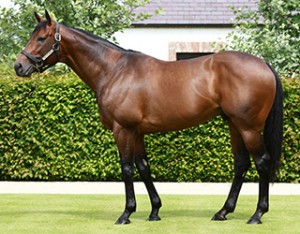 Taghrooda is an important horse for out continuing inquiry into how to concentrate classic speed in the racehorse for a number of reasons. The first is the fact that she is the first classic winner from the first crop of Sea the Stars the multiple classic winning half brother to the world’s leading sire Galileo. It’s beginning to look like Sea the Stars is about to follow in his brothers footprints as an important source of classic speed. It is my contention that these two stallions owe their extraordinary breeding ability to the fact that their dam Urban Sea and their Granddam, Allegretta are Cluster Mares. At this point Sea the Stars has only one classic winner but he has two more contenders waiting in the wings, one in France and the other in Germany.
Taghrooda is an important horse for out continuing inquiry into how to concentrate classic speed in the racehorse for a number of reasons. The first is the fact that she is the first classic winner from the first crop of Sea the Stars the multiple classic winning half brother to the world’s leading sire Galileo. It’s beginning to look like Sea the Stars is about to follow in his brothers footprints as an important source of classic speed. It is my contention that these two stallions owe their extraordinary breeding ability to the fact that their dam Urban Sea and their Granddam, Allegretta are Cluster Mares. At this point Sea the Stars has only one classic winner but he has two more contenders waiting in the wings, one in France and the other in Germany.
The second point of interest is that Taghrooda has a 3rd dam which has just achieved Cluster Mare status. The mare’s name is Ezana by Ela-Mana-Mou. Not only does she have Taghrooda tracing to her in tail female, but she has Queen Elizabeth II classic winning mare Estimate tracing to her as well. Estimate is two generations from Ezana while Taghrooda has her in the 3rd generation. Estimate’s dam not only produced her, but two other classic winning progeny in Ebadiyla (Irish Oaks, Prix Royal Oak), and Enzeli (Ascot Gold Cup). Ezana’s descendants have won 5 classic races within the required six generations giving her Cluster Mare status. Most likely more Cluster mares will appear in this female family in the next few generations. One can make this evaluation because Estimate’s dam alone has 10 well bred daughters in the hands of prominent breeders insuring they will receive the greatest of opportunity. Here are a couple of pedigrees to look at;
Ezima is the dam of Taghrooda while Ebaziya is a half-sister to Estimate. Both mares are by Sadler’s Wells out of daughters of Darshaan and the daughters of Darshaan are full sisters.
A summary of this family is that it originated the Marcel Boussac’s breeding program in 1919 with the addition of Banshee to the broodmare band. Inbreeding to Banshee produced Tourzima a foal of 1939. Since then a procession of classic winners have appeared including the following
| Classic Winner | Year Foaled | Races Won |
| Corejada | 1947 | French 1G, Irish Oaks |
| Macip | 1952 | Fr SL, Ascot Gold Cup |
| Appollonia | 1953 | French 1G, Oaks |
| Acamas | 1975 | French Derby |
| Akiyda | 1979 | Arc de Triomphe |
| Darshaan | 1981 | French Derby |
| Ebadiyla | 1994 | French SL, Irish Oaks |
| Enzeli | 1995 | Ascot Gold Cup |
| Sinndar | 1997 | Derby, Irish Derby, AGC |
| Taghrooda | 2011 | Oaks |
Tourzima quickly achieved Cluster Mare status doing so within two generations. Corejada, Macip, and Appollonia are within two generations of Tourzima and between them won six classic races when only five are required within six generations. To date Tourzima has 10 runners of 16 classic races tracing to her within six generations. More importantly for the future is the fact that the family has produced two more Cluster mares since Tourzima. They are Albanilla and Ezana. As previously mentioned a few more cluster mares are likely to emerge from this family in the next 10 years.
Tourizma
It’s important to know about cluster mares (the building blocks of the breed) and even more important to recognize those mares likely to earn cluster mare status in the future while they are still living. For more information refer back to the essay on Marcel Boussac and Estimate.
Apr 30
Occupy & Occupation
Welcome back dear readers to Broodmares Inc. where we are dedicated to searching for better ways to breed the classic racehorse.
Our last essay was on Heroic the great Australian racehorse from the early 1920’s. Today we’ll take another venture back into racing’s past to the early 1940’s to examine the full brothers Occupy and Occupation. If you’ve read my book Breeding by Design you’ll remember in my piece on sire line mythology the reasoning as to why no sire line can maintain its dominance for more than a few generations. Occupy and Occupation represents the demise of the dominance of the Domino line that had begun with his foaling in 1891. I go into the breeding of Domino in Breeding by Design but for those who haven’t had the chance to read it yet, you can find his story in an article I wrote for the Blood Horse.
The-breeding-behind-domino Domino had only 19 foals to live and his best son Commando had only 25. Even more remarkable is that Domino sired 8 stakes winners from his 19 foals for a 42% rate and Commando sired 10 stakes winners from 25 foals for a 40% rate. In today’s environment where a stallion that sires 10% stakes winners from foals is considered a top stallion you can see how extraordinary the achievements of Domino and his son Commando are. Domino was an inbred horse with three direct crosses of his own female line and multiple crosses of Lexington and Glencoe the two best stallions of the antebellum period. For about 40 years Domino’s blood was a dominant force in North American breeding. By the time we get to Occupation and Occupy, which are full brothers foaled in 1940 and 1941 respectively, the Domino influence is in decline. However, there is much to learn in this decline. The dam of Occupation and Occupy is Miss Bunting by Bunting. She is a mare heavily dosed with the blood of the inbred Mannie Grey. The 3rd dam of Miss Bunting is Dorothy Gray by Hamburg. This mare a foal of 1902 is incredibly inbred if you know who is related to whom. Hardly anyone would know that Vandal and Lexington trace to the same mare, Lady Grey by Robin Grey. Since Dorothy Gray has six crosses of Lexington and three of Vandal you can understand the extent of the inbreeding. More importantly Dorothy Gray is inbred to Mannie Gray 3×2.
Look at her pedigree here! Pedigree: Dorothy Gray
We can see that Dorothy Gray is the result of a stallion being used to reinforce his own female line. We also know that the horse she is inbred to is inbred herself carrying 3 crosses of the Galopade family. Now look at the male line of Bunting. It runs from Bunting to Pennant to Peter Pan to Commando to Domino. Here Miss Bunting picks up another direct cross of Mannie Gray from Domino. In effect we again have a Male line reinforcing the female line except in this case the female line is already inbred to Mannie Gray through Dorothy Gray. Miss Bunting picks up what I would call another interior cross of Mannie Gray as Hamburg is the sire of the 2nd dam of Bunting. The thing to remember is that Mannie Gray is in possession of three crosses of her own female line and Miss Bunting has 4 crosses of Mannie Gray.
Miss Bunting is a mare heavily dosed with the blood of the horses that were the foundation of the thoroughbred in North America. Then she is bred to Bull Dog who represents a total outcross and the result is the very speedy full brothers Occupation and Occupy. It would be the full brothers Bull Dog and Sir Gallahad III that would be the chief beneficiaries of American mares now heavily dosed with the blood of Domino, Lexington and Glencoe. So one era was ending and a new era in breeding was beginning. The new era would be represented by the influx of European Stallions such as the a fore mentioned Bull dog and Sir Gallahad and later Sickle, Pharamond II, and then finally Nasrullah, Royal Charger and Khaled. During their time of dominance Sir Gallahad III was leading sire in North America 4 times and leading broodmare sire 12 times. His full brother Bull dog was leading sire once and leading broodmare sire 3 times. This was followed by Bull Dog’s son Bull Lea being leading sire 5 times and leading broodmare sire 4 times. After this run taking place over 30 years the line gave way to that of Nasrullah and his descendants.
Occupy and Occupation present and interesting contrast. Occupation was the better racehorse meeting Triple Crown winner Count Fleet 3 times as a two-year-old and defeating him twice. In the Futurity Stakes Occupation won with Ask Me Now (champion two-year-old filly) 2nd and Count Fleet 3rd. Occupation probably lost the two-year-old champion title when Count Fleet beat him in the Pimlico Futurity. On the other hand Occupy also won the Futurity Stakes over co-champion two-year-old colt Platter but lost the Breeders Futurity to champion two-year-old filly Durazna. So while Occupation met and defeated stronger competition his full brother earned a championship. As breeding animals Occupy was distinctively better than was his full brother. However it was not because either brother left any impact on the male side of pedigrees. It was as broodmare sires that the brothers left their only impression. Occupation is only remembered through his daughter No Strings who is the dam of champion two-year-old colt Nail, as well as Globemaster and Mito. Occupy’s daughters achieved at a higher level producing among others Habitat and Northfields. Habitat was leading broodmare sire in Great Britain four times, and Northfields is the sire of Broodmare of the Year Northern Sunset. She achieved Broodmare of the Year status by producing three earners of over $1,000,000 and another that won $817,000. Little Hut by Occupy the dam of Habitat and Northfields is also the 4th dam of Sauve Dancer which won the French Derby and Prix de l’Acr de Triomphe. Occupy left an indelible stamp on the stud book though his daughter Bridgework the 2nd dam of Kris S. without her there would be no Kris S. and therefore no Zenyatta. Keep in mind that the only reason I presented this essay to you was to highlight the dam of Occupy and Occupation, Miss Bunting who is a classic example of male line reinforcement of the female family Until next time dear readers here’s wishing you the best of racing luck.
Apr 30
Miss Gunning
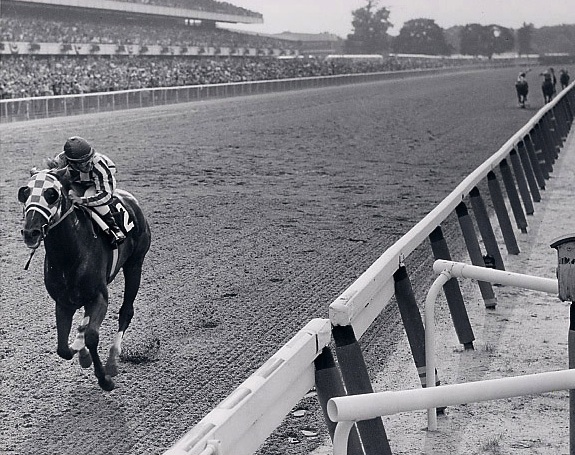
When Secretariat won the 1973 Belmont Stakes by 31 lengths in record time he was catapulted into immortality.
When Secretariat won the 1973 Belmont Stakes by 31 lengths in record time he was catapulted into immortality. There is another horse which raced 120 years ago who ran a race just as incredible as that run by Secretariat in the 1973 Belmont Stakes. The horse is Carbine and the race was the 1890 renewal of the Melbourne Cup run over two miles. Carbine’s victory threw the spectators into a riot of excitement and jubilation-“many people became hysterical in their delight; women shrieked and even wept; and quite decorous old gentleman in frock coats and toppers abandoned their head-gear and shook hands with everyone within reach”.
What brought about this riot of excitement? Carbine had won Australia’s most important race run over 2 miles carrying 145 pounds against a field of 38 competitors by three lengths in record time while giving the 2nd place finisher a 53 pound weight concession. Compare this to Dr. Fager’s immortal race in the 1968 Vosburgh Handicap carrying a 139 pound impost and getting 7 furlongs in 1:20 1/5 and giving the 2nd place finisher 12 pounds.
Why would I bring up this particular race run 124 years ago? It all harkens back to the mission of this web site and my book which is Breeding by Design. All of you who have been in this industry long enough have heard the famous slogan of one of racing’s master horse salesman Leslie Combs of Spendthrift Farms, “Breed the Best to the Best and Hope for the Best”. Sounds great except it hardly ever works, but it does work occasionally. The Blood Horse years ago put out a list of the top selling yearlings from the Saratoga Yearling Sale. The list covered a 50 year period and what it showed was that only two of the highest selling yearlings from this select yearling sale ever earned back their purchase price.
I chose to start this essay with Carbine because he is from one of my favorite families and it illustrates how certain patterns when created lead to classic ability. It doesn’t really matter whether these patterns are the result of planned mating or by accident as long as they occur.
How let’s take a look at Carbine’s pedigree to see what we can learn.
It’s easy to see that the great Carbine is inbred to Brown Bess who is a cluster mare. This particular form of inbreeding is similar to the inbreeding found in The Tetrarch who is inbred to the cluster mare Rouge Rose.
Before we go any further you should know that that Musket the sire of Carbine is the result of breeding a stallion back to his own female line. Both the sire of Musket, Toxophilite and his dam West Australian mare trace to another cluster mare that being Everlasting by Eclipse.
Brown Bess is a cluster mare who has a few other cluster mares tracing to her within a few generations. One is Quiver and another Miss Gunning.
Brown Bess earned cluster mare status by having the following trace to her within 6 generations.
| Horse | Races Won | Generations Back |
| General Peel | 2,000 Guineas | 2 |
| Memoir | Oaks, St Leger | 3 |
| La Fleche | 1,000 Guineas, OaksSt. Leger. Ascot Gold Cup | 3 |
| Ayesha | German Oaks | 5 |
| Straitlace | Oaks | 5 |
| Cinna | 1,000 Guineas | 5 |
| Sunbonnet | Kentucky Oaks, Alabama | 5 |
Brown Bess who required 2 or more winners of 5 classic races within 6 generations to earn cluster mare status, has 7 winners of 12 classics. Just like her granddam, Quiver also earned cluster mare status. The horses that make her a cluster mare follow:
| Horse | Races Won | Generations Back |
| Memoir | Oaks, St. Leger | 1 |
| La Fleche | 1,000 Guineas, Oaks, St. Leger, Ascot Gold Cup | 1 |
| Cinna | 1,000 Guineas | 3 |
| Sunbonnet | Kentucky Oaks, Alabama | 3 |
| Haintonette | Irish Oaks | 4 |
| Uganda | French Oaks, St. Leger | 5 |
| Avestruz | Argentine Oaks | 6 |
| Ukrania | French Oaks | 6 |
| Udaipur | Oaks | 6 |
Not a bad record; 9 winners of 15 classic races. This does not include the non classic winning Polymelus who was five times leading sire in Great Britain in whose pedigree Quiver appears as the granddam.
This brings us to the subject of this essay Miss Gunning who is also a cluster mare. (See why I like this family) Just as Polymelus is a grandson of Quiver, Miss Gunning is a granddaughter of the same mare. The difference is that Miss Gunning is inbred to Brown Bess using the male line to reinforce its own tail female line.
When looking at the pedigree of Miss Gunning one thing becomes very clear, that being, Musket and Quiver are genetic relatives both being sired by Toxophilite and out of daughters of Brown Bess. Since Toxophilite and Brown Bess trace to the same mare this gives Miss Gunning 4 crosses of her tail female line. This is probably what gave her the concentration of classic speed that led to her achieving cluster mare status. The horses that made Miss Gunning a cluster mare are:
| Horse | Races Won | Generations Back |
| Uganda | French Oaks, St. Leger | 3 |
| Ukrania | French Oaks | 4 |
| Udaipur | Oaks | 4 |
| Palestine | 2,000 Guineas | 5 |
| Umiddad | Ascot Gold Cup | 5 |
| Hindostan | Irish Derby | 6 |
| Fiorentina | Irish 1,000 Guineas | 6 |
| Samba | Italian Oaks | 6 |
| Claro | Irish 2,000 Guineas | 6 |
Again we have another cluster mare from this family with the sterling record of 9 winners of 10 classic races within 6 generations.
The following classic pedigrees are further examples of horses inbred to this family using stallions to reinforce the female line.
Poudre a Canon the 3rd dam of German Oaks winner Ayesha
Cinna, 1000 Guineas winner and dam of Beau Pere
Victrix, winner of the French St. Leger. His dam inbred to la Fleche
San Jorge winner of the Argentine Derby, dam inbred to Brown Bess
Avestruz winner of the Argentine Oaks. 3rd dam Lady Spearmint inbred
Udaipur won Oaks inbred to Quiver
Pedigree: Udaipur
If you’d like to see a example of a Miss Gunning descendant in the modern thoroughbred look no further than Wild Again a first class sire and the winner of the first running of the Breeder’s Cup Classic. He traces to Miss Gunning down his tail female line as she is his 8th Dam. Wild Again’s 4th dam is the previously mentioned Udaipur who is inbred to the cluster mare Quiver. Wild Again’s 2nd dam Dama picks up another strain of Quiver through the direct male line of Dante which leads to Polymelus. Wild Again’s sire Icecapade’s male line also leads to Polymelus.
Before I close this essay I’d like to mention what is becoming more apparent with every passing month. That is the use of drugs in American Racing. To show what this has led to over the past 50 years look no further then my favorite racehorse when I was a teenager, Round Table. He started
66 times and won 43 races. Today he would be considered a super horse and a marvel. Round Table carried 130 pounds or more 25 times and won 17 of those races. During a 20 week period in the middle of his three-year-old campaign he started 11 times, averaging one start every two weeks, and won them all. This included 3 races run at 1 ¼ miles, the Hollywood Gold Cup, the Hawthorne Gold Cup, and the American Derby. In the 1st two mentioned races, the Gold cups, he defeated older horses. Is there any such horse living today?

One of the most controversial topics in Thoroughbred racing today is the race-day use of furosemide (commonly called Salix or Lasix).
What seems to be the main culprit?
It would seem to me it’s Lasix. This is a performance enhancing drug! Very few horses are bleeders and yet 94% of the starters in North America are running on Lasix. It is a diuretic which can cause a horse to loose 25 pounds in hours which translates into his carrying 25 less pounds in a race. The problem is that it takes weeks or months for the horse to recover. Is this why the racing jurisdictions are moving the Derby preps further and further back from the first Saturday in May? The Wood Memorial used to be run two weeks before the Kentucky Derby as did the Arkansas Derby and the Blue Grass Stakes, but not anymore. George Strawbridge Jr. the owner of Moonlight Cloud said in an article in the online magazine of the Thoroughbred Daily News that the reason American horses can’t be quickly run back anymore is probably because of Lasix. He said, “The recovery time would not allow it”. Whenever you dehydrate a horse to that extent it is not possible. Look at human athletes, they don’t dehydrate themselves before they race.”
For that matter is that what is causing the decline in the performance of Midnight Hawk. This horse has had more Kentucky Derby preps than any other horse. If he’s running all of these races on Lasix what is the debilitating effects. Unless you’re in the barn with the horse you’ll never know. How do those fans which gambol on horse racing handicap this? How are they supposed to know how long it takes for each individual horse to recover from the effects of Lasix? The answer is there is no way of knowing.
I think it was Bill Oppenheim of The Thoroughbred Daily News who said a few weeks ago that the United States for many years was the domicile for the top commercial stallions. He related that in 2013 of the top 5 commercial Stallions world wide, not one stood in North America.
I hope when the Jockey Club meets in August they find a solution to this problem. We can’t go against the rest of the racing world and come out ahead.
Apr 30
California Chrome
Saturday the 8th of March witnessed the running of the San Felipe Stakes which was won very impressively by a California Bred appropriately named California Chrome. Before we take up California Chrome and why a rather obscure California stallion such as Lucky Pulpit sires a Kentucky Derby contender I’d like to present to you my thoughts leading up to the San Felipe Stakes.
This is what I had written:
March 8th was the running of the San Felipe Stakes. Like most racing fans I’m puzzled by the performance of Midnight Hawk in the Robert B. Lewis Stakes a month ago. In my opinion this shows the best reason not to bet on horses. After much consideration I came to the conclusion that Midnight Hawk was not so much out to win the Robert B. Lewis Stakes as he was in it to be schooled for bigger things ahead.
Why did I come to this conclusion? For one thing the work pattern leading up to the race was unusual. 11 days prior to the race he worked 5 furlongs in a leisurely 103.20. Why would one find this work unusual? For one thing Midnight Hawk is a fast work horse. Prior to the Sham Stakes he worked 5 furlongs in 58 and change. It would seem to me that the slow work in preparation for the Robert B. Lewis was to take the edge off a horse that was going to use the Lewis for schooling to teach him to rate. Remember, one does not go to stud with a $100,000 stud fee for winning races like the Robert B. Lewis, but one does if they win races like the Kentucky Derby or the Triple Crown. Midnight hawk is a headstrong horse which needs to learn to rate. He has another Bad habit which is bearing in and trying to get to the rail. If you watch the running of the Robert B. Lewis closely you will see that Mike Smith does not get into Midnight hawk at the head of the stretch as does Gary Stevens does on Candy Boy. He hand rides him as if the only way he is going to win is if he is much the best. Smith only hits Midnight Hawk once about 70 yards for the wire. Midnight Hawk did not gallop out strongly either but did it like a tired horse. Now, for the San Felipe these are his works; Feb. 16th 4f in 47.80, Feb 21st 5f in 59.60, Feb 26th 5f in 58.80 and today 4 days before the San Felipe 4f in 49.40. The works say he is ready for a top effort but what is undecided is did he learn to rate. The key factor to watch where Midnight Hawk is concerned is does Mike Smith stay on him as his Derby mount. He will know better than anyone if Midnight Hawk is leaning his lessons. One last thing to keep in mind is what I mentioned in the original essay on Midnight Hawk, this concerns his connections. Remember, when the same people were preparing Midnight Hawk’s grandsire Real Quiet for the Kentucky Derby he did not win a single prep race leading up to the Derby. Real Quiet’s preparation for the Derby consisted of an 8th place finish in the Golden Gate Derby on January 18th beaten 22 lengths. Followed by a 2nd place finish, beaten a head in the San Felipe Stakes on March 14th. On April 4th he ran 2nd by 2 ¼ lengths to Indian Charlie in the Santa Anita Derby. From there on it was a different story, 1st in the Kentucky Derby by a ½ length, 1st in the Preakness Stakes by 2 ¼ lengths and 2nd in the Belmont Stakes by a nose. Where Midnight Hawk is concerned watch and see if he can be rated.
Since I wrote the above Midnight hawk has run three more races finishing 2nd in the San Felipe to California Chrome, 2nd in the Sunland Park Derby to his stablemate, Chitu, and then this past Saturday another 2nd in the Illinois Derby to Dynamic Impact a horse which prior to the Illinois Derby had only won a maiden race. So what can be said about Midnight Hawk at this point? First, he is sound. He has made 5 starts all in graded stakes since the 1st of the year. Second he is fast. He was up near the lead in the San Felipe after a mile in 1:33 4/5. So what is his problem. I would say immaturity of the mental sort. It might be a good idea to give him a vacation and bring him back later in the year.
This brings us to California Chrome and his brilliant victory in the San Felipe during which Midnight Hawk after getting off to a slow start rated fairly well a neck behind the leader. Although Midnight Hawk ran well California Chrome ran even better. Keep in mind that if California Chrome had not been in the race Midnight Hawk would have won it by 6 ¼ lengths.
In the race California Chrome led all the way with fractions of 23.09, 45.55, 109.45, 133.94, 140.59. Granted the track was lightening fast where Game on Dude raced through a mile in 132.57 close to the world’s record on dirt for the mile, and 158.17 close to the 1 ¼ mile world mark. Still, pushed by Midnight Hawk, California Chrome left that one in the dust as they turned for home. Midnight Hawk did not break well bumping with another horse before rushing up into a contending position going four wide into the clubhouse turn. Nevertheless, there was no way Midnight Hawk was going to beat California Chrome on this day as the winner pulled away with surprising ease down the stretch.
Up until this race I had paid little attention to California Chrome a relatively unheralded California Bred. When I looked at his dam I was not too very surprised by what I found. In fact, the pedigree of the dam of California Chrome and the dam of his great grandsire Seattle Slew are very similar. If you recall Seattle Slew sold for only $17,500 primarily because his sire Bold Reasoning was not that well thought of and Seattle Slew was from his first crop. In the case of Seattle Slew and California Chrome their dams may provide the answer as to where the racing ability originated.
First look at the pedigree of Love the Chase the dam of California Chrome. She is inbred to Numbered Account the champion two-year-old filly of 1971.
It is important to note that Numbered Account is inbred to La Troienne through both her sire Buckpasser and her dam Intriguing. Since Numbered Account appears twice in Love the Chase’s pedigree it gives her daughter 4 crosses of La Troienne. In Love the Chase’s pedigree her sire Not for Love traces to Numbered Account as does Polish Navy the sire of her dam. In Seattle Slew’s dam My Charmer, her sire Poker traces to Baby League (a daughter of La Troienne) and her dam’s sire, Jet Action also traces to Baby League and thence to La Troienne.
One other additional note on My Charmer, her dam Fair Charmer has the pedigree pattern that often leads to a concentration of classic speed. Her sire Jet Action traces down his female line to Myrtlewood’s dam Frizeur and so does her dam.
If California Chrome continues to advance in the way he has to date only bad racing luck will prevent him from wearing the blanket of roses the 1st Saturday in May
Here is one last thought on the upcoming classics. My favorite horse when I was a teenager was Round Table. By today’s standards he was a mighty horse, maybe even a super horse. He started 66 times and won 43 races. He carried 130 pounds or more 25 times and won 17 of those races. In one 20 week period he started 11 times. He started on average every two weeks during that period and won all 11 races. These races included 3 at 1 ¼ miles including the Hollywood Gold Cup and Hawthorne Gold Cup against older horses and the American Derby against his own age group. Where is such a horse today? The reason we don’t have them anymore is drugs. The American racehorse used to be the world’s strongest and soundest and now we are beginning to push back the preps races for the classic’s because Lasix’s is a debilitating drug that takes so much weight off a horse that it takes weeks for the horse to recover. George Strawbridge Jr. the owner of top European Sprinter Moonlight Cloud said in the Thoroughbred Daily News Magazine that the reason American horses can no longer bounce back in a week or two is because of Lasix. “The recovery time would not allow it,” he says. “Whenever you dehydrate a horse to that extent it is not possible. Look at human athletes, they don’t dehydrate themselves before they race.
Considering that very few horses that use Lasix are actually bleeders and that almost 95% of starters are running on it says a lot. How can you handicap this when you have no idea how fast each individual horse takes to recover. This could explain Midnight Hawk’s slow regression. If he runs on Lasix each time, and he’s had 5 preps, how much does this take out of him?
The truth is we’ll never know. I only hope that when the Jockey Club meets in August they will find a solution to this problem.
Feb 27
Red Reveur & Global View
Recently some interesting races have been run the winners of which should be brought to your attention. By now you know that I’m an adherent to the theory that stallions can be used to reinforce their own female line thereby concentrating classic speed the result of which can be a classic racehorse or a cluster mare.
The two horses in question both two-year-olds of 2013 are Red Reveur winner of the Hanshin Juvenile Fillies G1, and Global View who was victorious in the Generous Stakes G3 run at Hollywood Park. There are distinct similarities in their pedigrees which will be apparent.
We’ll start with Red Reveur who is now 3 for 3 but was lucky to hold off the hard charging favorite Harp Star by a nose. Red Reveur has a pedigree that closely matches two beautifully bred stallions that stand at Taylor Made Farm in Kentucky. The stallions are Eskendereya and Astrology. Both of these stallions are by leading sires in Giant’s Causeway and A P Indy respectively, and because of their breeding are top stallion prospects.
First let’s look at the pedigree of Red Reveur and then we’ll compare her to Eskendereya and Astrology.
The place to begin an examination of Red Reveur’s pedigree is her 5th dam Cosmah. (It should also be noted that Red Reveur’s 6th dam is Almahmoud) Cosmah is a cluster mare having such horses as Cannonade (Kentucky Derby), L’Emigrant, ( Poule d’Essai des Poulains) Tosmah, (Beldame, Arlington Classic) Halo (Lawrence Realization) Flawlessly (Champion), tracing to her in tail female.
From Cosmah we move a couple of generations forward to Red Reveur’s 3rd dam, Dancing Free by Dancing Count. While Dancing Count is an unheralded Maryland stallion he is important in one way. He is by Northern Dancer and is the first instance in this pedigree where a stallion is used to reinforce the female line. By breeding Dancing Count to Flamingo Way inbreeding to Almahmoud resulted. This inbreeding didn’t turn Dancing Free into an outstanding producer but it did set the stage for what would come later. An outcross stallion is then added to produce I’m Out the 2nd dam of Red Reveur before another reinforcing stallion in the form of Dixieland Band is added. Desaucered, Red Reveur’s dam has three crosses of her own female family which traces through Cosmah to Almahmoud.
When Stay Gold is bred to Desaucered to get Red Reveur the 2nd cross of Cosmah is added and the 4th cross of Almahmoud. Although not yet a classic winner Red Reveur has already won over 1 million dollars as a two-year-old, and has her classic year ahead.
The question remains how the pedigree of Red Reveur compares to that of the top stallion prospects Eskendereya and Astrology. We’ll take Eskendereya first. Like in the pedigree of Red Reveur, Eskendereya’s 5th dam is Cosmah. Their 3rd dams Dancing Free and Stellar Odyssey are bred almost exactly alike. The difference is that Dancing Free is by a son of Northern Dancer, in Dancing Count while Stellar Odyssey is by Northern Dancer himself. We all know that Dancing Count is no Northern Dancer although he provides the same inbreeding to Almahmoud albeit one generation further back.
By the time Aldabaran Light is bred to Giant’s Causeway to get Eskendereya there are 4 crosses of Almahmoud present two of which come through Cosmah. The 2nd cross of Cosmah in Eskendereya’s pedigree comes from the presence of Halo in Rahy. Red Reveur also has two crosses of Cosmah and 4 crosses of Almahmoud.
Astrology is in possession of different horses producing the same pattern. A good place to start our investigation of Astrology’s pedigree is with his 4th dam the Tulyar mare Animosity. She is inbred to the great cluster mare Plucky Liege through both her male and female line.
Pedigree Quiet Eclipse
When you look at the above three pedigrees you will see that Animosity and Quiet American are bred alike when considering that both are the result of using a stallion to reinforce his own female line. Considering this, Quiet Eclipse then has four direct crosses of Plucky Liege. By direct crosses I’m referring to those from the direct female line of one of the horses in question. In Quiet American it is through Fappiano and Demure. In Animosity it is from Bois Roussel and Hostility. In addition there are 5 more crosses of the full brothers Bull Dog and Sir Gallahad III to be found in Quiet Eclipse’s pedigree which are not direct crosses. We find that Quiet Eclipse is a mare with at least 9 crosses of the great cluster mare Plucky Liege.
Global View
Global View won the Generous Stakes G3 at the end of the final Hollywood Park meet. He should have a bright future in that he is a son of Galileo who began his racing career as a two-year-old in North America. So far he is 2 for 2 and is already a graded stakes winner. What brought the horse to my attention is that his dam Egyptian Queen by Storm Cat. She is inbred to her own female line as Storm Cat her sire is by Storm bird a son of South Ocean while Egyptian Queen’s 4th dam is also South Ocean. This family traces to the cluster mare Dark Display who is the ancestress of Battlefield (Travers, Withers) Spoken Fur (Coaching Club American Oaks), Green Tune (French 2,000 Guineas) and South Ocean herself (Canadian Oaks). In Global View’s pedigree are three different instances of the stallions being used to reinforce their own female families Galileo’s 2nd dam Allegretta is a result of this cross as is Quiet American. It will be interesting to watch the development of this young horse which is now at Tampa Bay Downs awaiting his 2014 debut
Pedigree Global View
Pedigree Egyptian Queen 5
Feb 27
Midnight Hawk – Hidden Classic Speed!
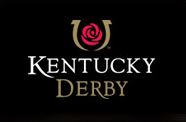 The Kentucky Derby is May 3rd.2014, a little over 64 days away. Now is the time when most racing enthusiasts begin to calculate which horse may be standing in the winners circle bedecked with the blanket of roses. As you can see from the title of this essay I’ve already made my choice based on pedigree. Although invariably there will be many well bred horses vying for the winners share and possible immortality I have chosen Midnight Hawk because he represents a breeding pattern that has in the past resulted in a concentration of classic speed. With that in mind let’s look at what makes Midnight Hawk a very strong classic candidate.
The Kentucky Derby is May 3rd.2014, a little over 64 days away. Now is the time when most racing enthusiasts begin to calculate which horse may be standing in the winners circle bedecked with the blanket of roses. As you can see from the title of this essay I’ve already made my choice based on pedigree. Although invariably there will be many well bred horses vying for the winners share and possible immortality I have chosen Midnight Hawk because he represents a breeding pattern that has in the past resulted in a concentration of classic speed. With that in mind let’s look at what makes Midnight Hawk a very strong classic candidate.

We should begin with his connections as he is owned by Michael E. Pegram and trained by Bob Baffert. This combination was responsible for bringing Real Quiet to within a hairs breath of winning the Triple Crown. Experience counts in almost any endeavor and that is very true when preparing a horse for the classics where once slip can spell disaster.
Midnight Hawk is by Midnight Lute who was a dual winner of the Breeder’s Cup Sprint. Because Midnight Lute won the Breeder’s Cup Sprint twice one might come up with the mistaken idea that he will be a sire of speed. In fact, it looks like the exact opposite effect is in play. Most of Midnight Lute’s offspring are winning at middle distances over a mile despite being produced from mares by very speedy broodmares sires.
The list includes;
| Horse | Races Won | Broodmare Sire |
| Mylute | 3rd Preakness 1 3/162nd Louisana Derby 1 1/8 | Valid Expectations |
| Govenor Charlie | 1st Sunland Park Derby | Storm Cat |
| Midnight Aria | 1st Queens Plate | Mt. Magazine |
| Midnight Ballet | 1st Sharp Cat Stakes | Unbridled’s Song |
| Midnight Lucky | 1st Acorn Stakes | Citidancer |
| Shakin It Up | 1st Strub Stakes | Vindication |
All of the races listed above are at 1 mile or over. The Queen’s Plate is Canada’s classic race run at 1 ¼ miles. Consider these additional facts. Mylute was 2nd beaten a neck by Revolutionary in the Louisiana Derby. Mylute then finished 3rd to Oxbow in the Preakness Stakes at 1 3/16 miles. Govenor Charlie won the Sunland Park Derby at 1 1/8 miles. Midnight Ballet finished 1st in the Sharp Cat Stakes at 1 1/16 miles. Midnight Lucky won the 1 mile Acorn Stakes by 6 ¼ lengths over Close Hatches and Kauai Katie and the Sunland Park Oaks at 1 1/16 miles by 8 lengths in track record time beating 588,000 earner Unusual Way. The versatile Shakin It Up won the 7 furlong Malibu Stakes G1 before beating his stable mate Govenor Charlie in the 1 1/16 Strub Stakes. The broodmare sires of Midnight Lute’s best runners are not noted to be great stamina influences. Midnight Aria winner of the 1 ¼ mile Queen’s Plate is out of a daughter of Mt.Magazine and unraced son of Mr. Prospector. Even Storm Cat’s daughters, as good as they are as broodmares, are not known for producing classic winners. This leads one to believe that Midnight Lute will prove to be an influence for stamina especially when bred to classic type broodmares.
 Where Midnight hawk is concerned we can see he has the right connections, and he is by the right sire. Our next concern is what does his dam contribute to the equation? Midnight Hawk is the produce of the Wolf Power mare Miss Wineshine. Although Wolf Power can’t be compared to a stallion like A P Indy as a broodmare sire, he does compare favorably in one area. Whereas A P Indy’s daughters have over the last few years produced no less than 15 runners that have earned a racing index of 100 or higher, Wolf Power’s produced only two. A horse with a 100 racing index earns the equivalent of the average purse for the year in which it races, per start. A horse with a 1000 racing index earns 10 times the average purse per start.
Where Midnight hawk is concerned we can see he has the right connections, and he is by the right sire. Our next concern is what does his dam contribute to the equation? Midnight Hawk is the produce of the Wolf Power mare Miss Wineshine. Although Wolf Power can’t be compared to a stallion like A P Indy as a broodmare sire, he does compare favorably in one area. Whereas A P Indy’s daughters have over the last few years produced no less than 15 runners that have earned a racing index of 100 or higher, Wolf Power’s produced only two. A horse with a 100 racing index earns the equivalent of the average purse for the year in which it races, per start. A horse with a 1000 racing index earns 10 times the average purse per start.
While Wolf Power has had only two daughters produce high indexed runners with indexes of 100 plus the two happen to be multiple Santa Anita Handicap winner Milwaukee Brew with a 759 index and multiple Horse-of-the-Year Wise Dan with an index of 1139. This proves that Wolf Power’s daughters can produce runners of the highest class when other contributing factors are present.
Miss Wineshine’s racing index is 249. She was a very good two-year-old being a stakes winner who placed 2nd to two-year-old champion Chilukki in the Debutante Stakes at Churchill Downs and 3rd in the Spinaway Stakes G1 at Saratoga. In the Spinaway the filly that finished 2nd ahead of Miss Wineshine was Surfside the following year’s champion three-year-old filly. A Summation of Miss Wineshine finds her to be a fast, sound filly which raced against the best and is sired by a broodmare sire that can get a mare which produces runners of the highest quality.
Now we get to the hidden factor that makes me think that Midnight Hawk will develop into a leader of his crop. If you look down his tail female line you will come to a mare named Best Dress a daughter of Roman and a foal of 1943. The following is a link to her pedigree.
It’s easy to see that Best Dress is inbred to her own female line through Roman’s sire Sir Gallahad III and his full sister Marguerite De Valois. The dam of both of these horses is the immortelle matron Plucky Liege who produced 4 leading sires in Bull Dog, Sir Gallahad III, Admiral Drake and Bois Roussel. This cross of inbreeding to Plucky Liege is not an anomaly. One only has to look at the pedigree of Horse of the Year Roman Brother to see the exact same pattern. His dam Roman Zephyr is bred almost exactly like Best Dress. The only difference is the dam of one is by Man o’ War and the dam of the other is by haste. All of the other horses in the pedigree are the same.
Obviously when Plucky Liege was reinforced in Roman Brother’s dam a champion was the result, but when the same pattern reoccurred in Best Dress nothing happened. In the case of Midnight Hawk a second chance for the glory may be on the horizon. If you haven’t read my book Breeding by Design you might not understand the full implications of what I’m about to show you. If you follow the male line of Midnight Hawk you will come to his grandsire Quiet American. Like Roman Zephyr and Best Dress he is inbred to his own female line through sire and dam. Look at his pedigree
Quiet American is inbred to Cequillo through both sire and dam. When you look at Cequillo’s pedigree you see that she traces through Marguerite De Valois to Plucky Liege. This scenario allows the male line of Quiet American (that of Fappiano) to reinforce the female family to which it is traces. Midnight Hawk has a quadruple cross of his own foundation female line and this very often leads to a concentration of classic speed.
From my perspective Midnight Hawk has everything going for him. Top connections, up and coming classic sire, exactly the right sort of broodmare, and a quadruple cross of his foundation female line which often leads to classic success. He may not win the Derby but I think he will develop into a top three-year-old. For more information on concentrating classic speed visit broodmaresinc.com. If the concentration of classic speed takes place, as it likely will, then on the 1st Saturday in May watch out for Midnight Hawk!
Feb 27
Heroic
In the book Great Thoroughbred Sires of the World Bill Whittaker calls Heroic the greatest all-around Australian bred Thoroughbred. That is a great accolade to place on Heroic making him an interesting subject for discussion. Whittaker goes on to say
“This handsome, prepotent son of Valais won 21 races from 5 furlongs to two miles in the best of company. He was tough and most importantly sound.”
As a stallion he led the sires list in Australia for 7 consecutive years until when 15 years of age he decided he was no longer interested in breeding mares. Since this website is dedicated to finding patterns that could reveal classic ability let’s look at Heroic’s pedigree.
When looking at his dam Chersonese we see that she is a daughter of the great cluster mare Chelandry. We already know that Chelandry was inbred to her own foundation female line. She traces to Ellen Horne down her tail female line and picks up the 2nd cross from her great grandsire Bend Or. Heroic’s dam Chersonese picks up further reinforcement as her sire Cylgad has Bend Or as his great grandsire. Chersonese is in possession of three direct crosses of Ellen Horne.
That is the first half of the equation.
The 2nd part of the equation that makes Heroic what he is comes from his sire Valais.
Heroic’s sire Valais was nothing approaching a great racehorse but he did manage to win the very minor Newmarket Windsor Stakes. He was a much better stallion when imported to Australia where he not only sired Heroic but also Manfred who is sometimes mentioned in the same breath as Phar Lap. Valais is a son of Derby winner Cicero. A good place to begin with the examination of Valais is his 2nd dam Hamptonia. This mare is inbred to Beeswing through her son the great Newminster and his full sister Honeysuckle. With this powerful reinforcement Hamptonia earned the status of a star mare having produced 3 winners of 3 classics within the required 6 generations. They are Ixia (Irish Oaks), Pendennis (French 2,000 Guineas), Satanica (Argentine 1,000 Guineas). Hamptonia is important in this story here is her pedigree
Next look at the pedigree of Cicero the sire of Valais. Cicero’s dam is Gas by Ayrshire. You can see that Ayrshire is bred on the exact same pattern as Hamptonia. Newminster on top, and his full sister Honeysuckle on the bottom.
Ayrshire won the Derby, 2,000 Guineas, and Eclipse Stakes showing again that the pattern of using the male line to reinforce the female line works to produce classic ability. Remember Hamptonia with the same cross although not a classic winner developed into a star mare. One story concerning Ayrshire I’d like to pass on to you. His dam is the cluster mare Atalanta by Galopin. She once sold for seven shilling and sixpence (about 2 dollars), a wheelbarrow, and a service to a boar hog. She achieved cluster mare status by having the following trace to her within six generations. The previously mentioned Ayrshire, Bubbling Over (Kentucky Derby), Edelweiss (Coaching Club American Oaks), Brignano (Italian 2,000 Guineas), Hevresac II (11 times leading sire in Italy). She is also the 7th dam of Triple Crown winner Whirlaway.
Getting back to Cicero we see that he is bred on the exact same pattern as Chelandry. Just as Ayrshire and Hamptonia are bred alike; Cicero and Chelandry are bred alike in the same way. Cicero is the result of breeding a stallion from the male line of Bend Or (Cyllene) to a daughter of Illuminata (Gas). Chelandry is the result of breeding a stallion from the male line of Bend Or (Goldfinch) to Illuminata herself. Valais emulates Heroic’s dam in that he picks up a 3rd cross of Ellen Horne from his dam who is by Bend Or’s son Martagon. We then find Heroic’s sire Valais with 3 crosses of Ellen Horne and his dam Chersonese with 3 more.
Finally, it is important to recognize that Heroic is bred on the same pattern as Cicero and Chelandry. His grandsire Cicero traces to Illuminatta as does his dam Chersonese. In the case of Heroic he just happens to have six crosses of Ellen Horne, 3 from his sire and 3 from his dam.
Looking back at the essay on Midnight Hawk we see that he is inbred to Plucky Liege the same way that Heroic is inbred to Ellen Horne. In the case of Midnight Hawk he gets 2 crosses from his male line and 2 crosses from his female line. Is that enough to make him a classic horse? We shall see soon enough dear readers.




